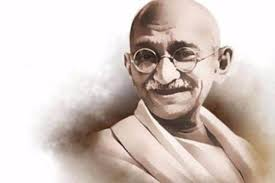Mahatma Gandhi Jayanti | 03 Oct 2020
Why in News
2nd October 2020 was the 151st birth anniversary of the Father of the Nation - Mahatma Gandhi. The Swachh Bharat Diwas, 2020 was celebrated on the occasion of Gandhi Jayanti with the distribution of Swachh Puraskar by the Ministry of Jal Shakti.
- Gandhi was a social reformist and leader of Indian Independence Movement who introduced the idea of nonviolent resistance called Satyagrah.
Key Points
- Birth: 2nd October 1869 in Porbandar (Gujarat)
- Brief Profile: Lawyer, politician, social activist, and writer who became the leader of the nationalist movement against the British rule of India.
- Satyagrah: In South Africa (1893-1915), he had successfully fought the racist regime with a novel method of mass agitation, which he called satyagraha.
- The idea of satyagraha emphasised the power of truth and the need to search for truth.
- It suggested that if the cause was true, if the struggle was against injustice, then physical force was not necessary to fight the oppressor. Without seeking vengeance or being aggressive, a satyagrahi could win the battle through nonviolence. This could be done by appealing to the conscience of the oppressor.
- People – including the oppressors – had to be persuaded to see the truth, instead of being forced to accept truth through the use of violence. By this struggle, truth was bound to ultimately triumph.
- The International Day of Non-Violence is observed on 2nd October, the birthday of Mahatma Gandhi.
- Gandhi Peace Prize is given for social, economic and political transformation through non-violence and other Gandhian methods.
- Return to India: He returned to India from South Africa on 9th January 1915.
- Pravasi Bharatiya Divas (PBD) is celebrated on 9th January every year to mark the contribution of Overseas Indian community in the development of India.
- Satyagraha Movements in India: Mahatma Gandhi believed that the dharma of non-violence could unite all Indians.
- In 1916 he travelled to Champaran in Bihar to inspire the peasants to struggle against the oppressive plantation system.
- In 1917, he organised a satyagraha to support the peasants of the Kheda district of Gujarat. Affected by crop failure and a plague epidemic, the peasants of Kheda could not pay the revenue, and were demanding that revenue collection be relaxed.
- In 1918, he went to Ahmedabad to organise a satyagraha movement amongst cotton mill workers.
- In 1919, he decided to launch a nationwide satyagraha against the proposed Rowlatt Act (1919).
- The Act gave the government enormous powers to repress political activities, and allowed detention of political prisoners without trial for two years.
- On 13th April, 1919 the infamous Jallianwalla Bagh incident took place. Seeing violence spread, Mahatma Gandhi called off the movement (18th April, 1919).
- Non-Cooperation Movement (1920-22): At the Calcutta session of the Congress in September 1920, he convinced other leaders of the need to start a non-cooperation movement in support of Khilafat as well as for swaraj.
- At the Congress session at Nagpur in December 1920, the Non-Cooperation programme was adopted.
- In February 1922, Mahatma Gandhi decided to withdraw the Non-Cooperation Movement after the Chauri-Chaura incident.
- The Salt March and the Civil Disobedience Movement: For several years after the Non-cooperation Movement ended, Mahatma Gandhi focused on his social reform work.
- In 1930, Gandhiji declared that he would lead a march to break the salt law.
- According to this law, the state had a monopoly on the manufacture and sale of salt.
- The march was over 240 miles, from Gandhi's ashram in Sabarmati to the Gujarati coastal town of Dandi, where they broke the government law by gathering natural salt found on the seashore, and boiling sea water to produce salt.
- This marked the beginning of the Civil Disobedience Movement.
- In 1931, Gandhi accepted a truce (the Gandhi-Irwin Pact), called off civil disobedience, and agreed to attend the Second Round Table Conference in London as the sole representative of the Indian National Congress.
- After returning from London, Mahatma Gandhi relaunched the Civil Disobedience Movement. For over a year, the movement continued, but by 1934 it lost its momentum.
- In 1930, Gandhiji declared that he would lead a march to break the salt law.
- Quit India Movement:
- With the outbreak of World War II (1939-45), the nationalist struggle in India entered its last crucial phase.
- The failure of the mission of Sir Stafford Cripps, a British cabinet minister who went to India in March 1942 with an offer that Gandhi found unacceptable, the British equivocation on the transfer of power to Indian hands, and the encouragement given by high British officials to conservative and communal forces promoting discord between Muslims and Hindus impelled Gandhi to demand in the summer of 1942 an immediate British withdrawal from India—what became known as the Quit India Movement.
- Social Work:
- He worked for the upliftment of untouchables and gave them a new name 'Harijan' meaning the children of God.
- In September 1932, B.R. Ambedkar negotiated the Poona Pact with Mahatma Gandhi.
- His symbol of self-reliance - the spinning wheel - became a popular symbol of Indian Independence Movement.
- He played a key role in pacifying people and averting the Hindu-Muslim riots as tensions rose before and during the partition of the country.
- He founded the Hindustani Prachar Sabha in 1942 at Wardha in Maharashtra. The aim of the organisation was to promote Hindustani, a link language between Hindi and Urdu.
- He worked for the upliftment of untouchables and gave them a new name 'Harijan' meaning the children of God.
- Books Written: Hind Swaraj, My Experiments with Truth (Autobiography)
- Death: He was shot dead by Nathuram Godse on 30th January, 1948.
- 30th January is observed as Martyrs' Day.
